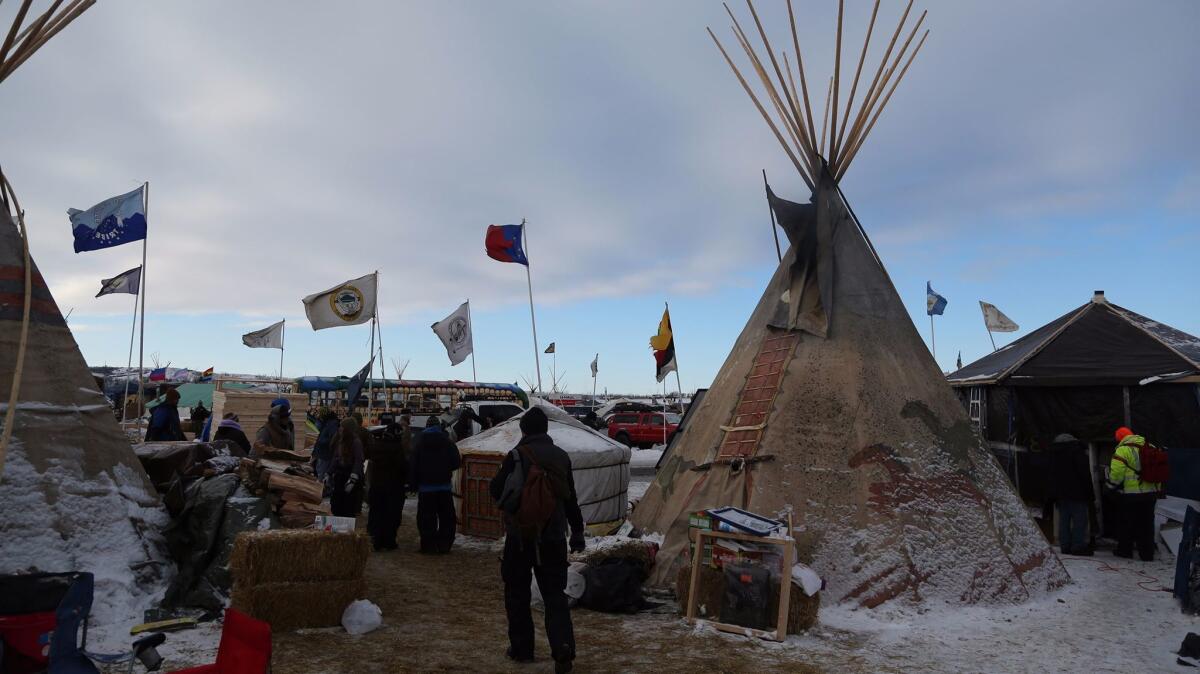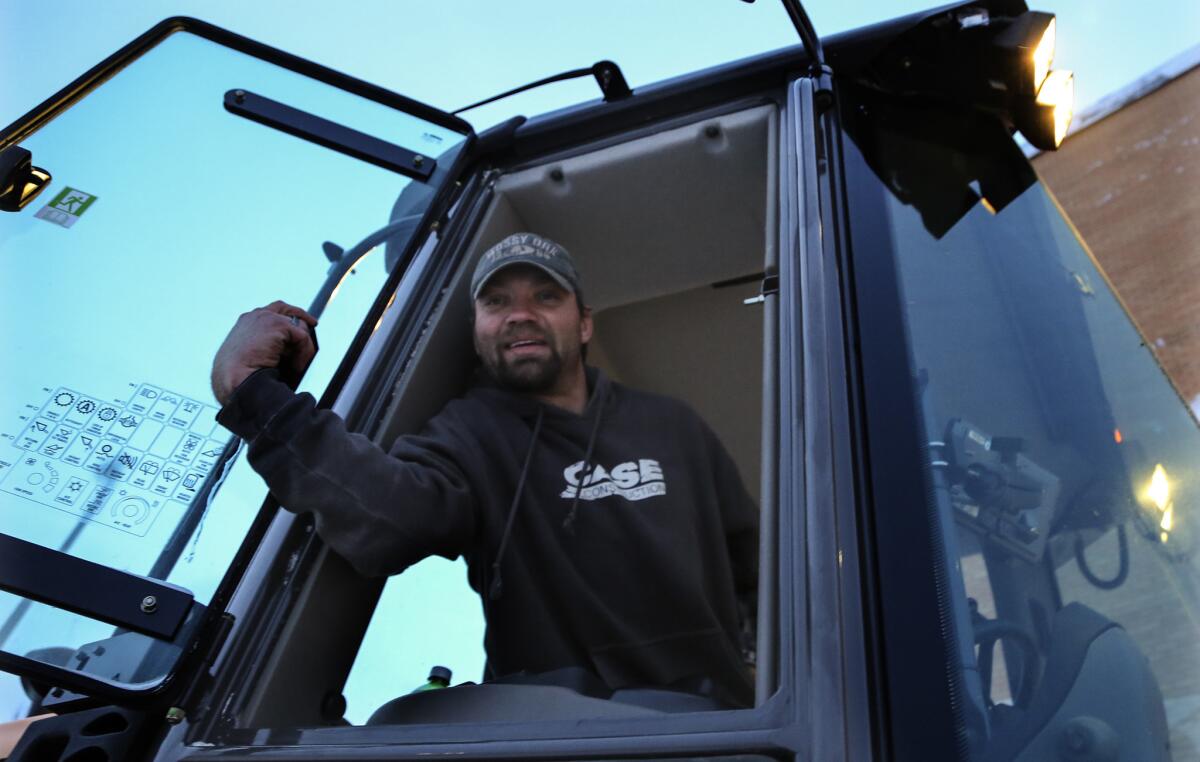Dakota Access protests expose raw divisions and emotions in North Dakota

- Share via
Reporting from Bismarck, North Dakota — As the battle over the Dakota Access pipeline intensified, Kirk and Lisa Wilson found themselves getting more angry and more annoyed — especially at the thousands of protesters who traveled to North Dakota from distant cities to confront local and state police.
“Don’t like it in the slightest,” said Kirk Wilson of the ongoing battle between protesters and North Dakota police over the $3.8 billion, 1,172-mile oil pipeline.
And so on a mild, windy Sunday morning in late November, the couple drove to a highway bridge spanning the towns of Bismarck and Mandan.
“We’re here to support the blue,” said Wilson, joining about a 1,000 others cheering, hollering, waving American flags and holding placards reading “Back the Blue.”
“They protect us, they keep us safe, and they make sure we go home at night,” Wilson added.
Another sign seemed to capture a sentiment felt by many in the state: “It’s Times to Take Our Great State and Communities Back.”
Cars whizzed past, drivers blaring their horns and whooping in support. Below the bridge, the Missouri River flowed south, toward the Standing Rock Sioux Reservation and the intensifying pipeline protests that have resulted in more than 500 arrests since August.
Everybody’s exhausted. This needs to be resolved.
— Lisa Wilson, on the pipeline protests
“Everybody’s exhausted,” said Lisa Wilson, a corrections officer for a nearby prison. “This needs to be resolved.” Especially wearying, she said, were the protesters “coming after our community” in Bismarck and Mandan, cities she said “have no bearing” on the fate of the pipeline.
The pipeline would pass under a portion of the Missouri River, and tribes and environmentalists believe an oil spill or leak would threaten water supplies. The opponents scored a victory this month when the Army Corps of Engineers denied an easement for the project while it issues an environmental impact statement.
But the project is far from dead. And despite subzero temperatures in recent weeks, more than a thousand “water protectors” remain camped near the Cannonball River, close to the pipeline route. The debate, and the protesters’ continuing presence, has exposed ill feelings and resentments dividing Native American tribes and the rest of the state.
Opponents of the pipeline note that the militarized police forces that have fired tear gas canisters and rubber bullets at protesters, spraying them with fire hoses in sub-freezing temperatures, are largely based in Bismarck and Mandan. Harold Frazier, chairman of the Cheyenne River Sioux Tribe, recently called for an economic boycott of the two cities.
Yet for residents of the predominantly white towns, it is the protesters who pose a violent threat — an image fostered by police and local media.
Although there have been instances of activists on the front lines hurling bottles, logs and rocks at police, the protests have largely been peaceful, despite authorities repeatedly referring to “rioting” and “rioters” when describing the confrontations.
Police also accused protesters of possessing pipe bombs, only to learn later that the objects were “chanunpas,” or peace pipes. Repeated police claims that protesters carried bows and arrows were later retracted. And recently in court papers officials who had charged a 37-year-old Lakota woman with attempted murder in a demonstration quietly dropped any mention of those charges, reducing them to felony possession of a firearm.
A “CodeRed Alert” issued by North Dakota officials over the Thanksgiving weekend warned the public “to be on alert to any suspicious activity.… Rioters in the area are intent on creating an unsafe environment for the public.” Local talk radio has regularly portrayed protesters, without citing evidence, as “terrorists.”
In this fearful climate many Bismarck and Mandan residents declined to be quoted by name, then expressed simmering rage toward “violent” protesters and condescension of Native American opponents of the pipeline.
One man, a retired ex-Marine, suggested protesters be arrested and put in outdoor cages in 40 below zero weather.
Another, a traveling salesman, asserted that were he the sheriff, armed forces would have long ago cleared out the main Seven Council Fires encampment near Cannon Ball, N.D., where recently up to 5,000 people planted tents and tepees to stop the pipeline. He then accused Native Americans of being drunk and lazy and suggested that tribal leaders opposing the pipeline could have been bought off with a few cases of beer.
Many people also expressed dismay or disdain, depending on the interview, of the deteriorating relations with the Standing Rock Sioux and nearby Cheyenne River tribes. One religious leader worried that relations with tribes have been set back decades. Among his flock are police and Native Americans; one Native American congregant, he said, is now afraid to travel alone in the city.
Some residents say they’re afraid to oppose the pipeline because they fear reprisals.
“We’ve had a lot of backlash,” said Lisa Wilson at the pro-police rally. “I myself have received many threats. Anytime I say, ‘Support the blue,’ I get messages upon messages.”
Pipeline protesters are targets of abuse, too. In a recent video that went viral, an enraged white man, his face hidden by a white hockey mask, rages at Native American protesters in their car, ordering them in obscene language to leave and leave quickly.
“The racism is there – I grew up witnessing this because I was a token,” said Didi Banerji, 51, a nurse who grew up in Fargo, and as a girl spent her summers harvesting barley and sunflowers on a North Dakota farm. Banerji is the daughter of a “Hindu Brahmin philosopher” and the maternal granddaughter of a Norwegian settler.
She said her grandfather inhabited an insular world of northern European immigrants, with little exposure to people of other backgrounds.
“They’re protecting their beloved land that they believe is theirs, because they’ve worked so hard to maintain this homogeneous culture,” said Banerji, who now works as a medic on behalf of the Standing Rock pipeline opponents. “What’s happened is this movement has scratched the surface” of the homogeneity, confronting North Dakotans’ isolation with radically different values.
Many North Dakotans are also angry that protesters are gunning for the state’s lifeblood, oil. The collapse of oil prices by nearly half since 2014 triggered a wave of bankruptcies and a gutting of North Dakota’s fracking industry.
In the hostile atmosphere, it is often hard to find anyone who sympathizes with multiple sides of the pipeline issue. But that rare example could be found one late afternoon in the bitter cold outside a snowy yellow brick warehouse in Bismarck. There, perched high in the cab of a snowplow, Corey Sayler cleared a path at the tail end of a blizzard.

“I think the industry needs progress,” said the bearded Sayler, 39, in a baseball cap and a blue hoodie emblazoned with the words Case Construction. “I think we need to figure out better ways to move this oil. Truckload after truckload isn’t good either. But one big snake going through the ground that could possibly get ruptured, that could be a big mess instead of a little mess. I don’t want anybody to get hurt by it.”
He added: “I think the pipeline is a great idea. But if they’re going through their native burial grounds, absolutely not. I wouldn’t want someone digging up my grandma and grandpa’s grave.”
Sayler jammed his gearshift in reverse and angled toward towering snow drifts. In general, protesting is a good thing, he said, and “if it was something I believed in a hundred percent, I would definitely be out there too. But in reality I think they’re kind of overdoing it.”
Sayler said he was prevented from traveling to his girlfriend’s place on Thanksgiving because protesters “had Main Street blocked off, so we couldn’t even get over to eat.”
“I see everyone’s point of view, I honestly do,” Sayler concluded, who then seemed to sum up the whole pipeline affair. “I mean, everything’s unfair. The whole thing’s unfair.”
Tolan is a special correspondent.
ALSO:
37 degrees below zero? Blame it on the return of the ‘polar vortex’
Ryan Zinke, Trump’s pick as Interior secretary, is all over the map on some key issues
Canadian government rejects pipeline through rainforests of British Columbia
More to Read
Sign up for Essential California
The most important California stories and recommendations in your inbox every morning.
You may occasionally receive promotional content from the Los Angeles Times.










